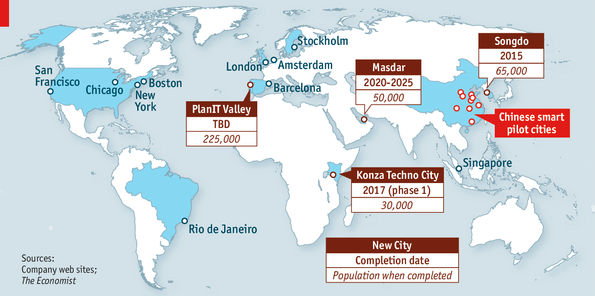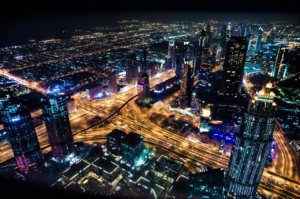Every designer dreams of seeing something go from the drawing board to reality – that is, designing and building something from the ground up. This is just as true for urban designers as it is for any other kind of designer. As I’ve noted in past posts, around the world there are several cities being designed and built from the ground up that have been designed to incorporate the latest technologies and whose aim is to make urban life more attractive and sustainable. The Economist calls these cities “urban dreamscapes” and reports that “building the city of the future is costly and hard.” [“Starting from scratch,” 7 September 2013] The article in The Economist was accompanied by a graphic showing where these urban dreamscapes are being built.

The first city discussed in the article is Masdar City. Plans for Masdar City were announced in 2006. I wrote my first post about the project in 2009 [Abu Dhabi’s Masdar Plan]. Back then, I wrote:
“The Masdar Initiative, if nothing else, is ambitious. If anyone can pull off ambitious plans, however, it is UAE leaders — as any visitor to the country can readily observe. … The Masdar Initiative is following a strategy that has been used successfully by many universities. It is going to establish a research institute to develop environmental technologies and a complementary ‘investment arm’ to implement and exploit them. The unique twist added by the Masdar Initiative is the ‘eco-city’ that will be home to these organizations. Masdar’s managers want to create an academic institution that rivals the Massachusetts Institute of Technology (MIT) and then surround it with ‘a global manufacturing hub for technologies such as solar power and desalination, and a city of 40,000 people with no greenhouse-gas emissions and no waste — all while turning a profit.’ Although the government of Abu Dhabi is putting up $15 billion in venture capital, it expects the investment arm and the city to be profitable.”
The following year I wrote a follow-up story on the Masdar plan [Update on Masdar City]. In that post, I wrote:
“Despite the global recession (which hit Dubai particularly hard), Abu Dhabi pressed forward with the planned city. The recession has, however, had an impact. The project is being scaled back and will no longer begin life as a carbon-neutral city.”
The Economist now reports:
“More than six years later the future looks a bit less fantastic. Most of Masdar, designed under the aegis of Norman Foster, a British architect, will not sit on a podium; though models of the self-driving pods may find a place in a museum, the pods themselves are off the menu. Conventional cars, or at best electric ones, will roam the streets instead. When there are streets to roam, that is: the city was supposed to be completed by 2016, but the date has been pushed back to between 2020 and 2025.”
Eric Jaffe reports that the Masdar Institute of Science and Technology, the university that was supposed to rival MIT, “right now [has] only a hundred or so students enrolled.” [“How Are Those Cities of the Future Coming Along?” The Atlantic Cities, 11 September 2013] The Economist reports that Masdar City isn’t the only project facing challenges. “Other much-hyped ‘smart-from-the-start’ cities,” the article states, “are showing similarly scant signs of success.” The next city it discusses is Songdo, a ground up city being built near Seoul, South Korea. The article reports: “Songdo … boasts flats and offices packed with built-in electronic hardware — in particular videoconferencing systems — but not people; few want to move there.” Back in 2010, Greg Lindsay called “New Songdo … the most ambitious instant city since Brasília 50 years ago.” [“Cisco’s Big Bet on New Songdo: Creating Cities from Scratch,” Fast Company, February 2010] He also noted that Brasilia “was an instant disaster: grandiose, monstrously overscale, and immediately encircled by slums.”
The next project discussed by The Economist was PlanIT Valley in Portugal. The article notes that PlanIT Valley “promises to be a wonder stuffed with sophisticated sensors. But though mooted since 2009, construction has yet to begin.” Jaffe describes the project this way:
“PlanIT Valley, situated outside Porto, Portugal, will be nothing if not a smart city. It was conceived by the Living PlanIT company, a developer of intelligent urban infrastructure, as a testing grounds for data-sensor technology. About 100 million real-time sensors will send information to a patented Urban Operating System designed to keep the whole built environment as efficient as possible.”
Last year, Will Doig dubbed PlanIT Valley “the perfect city.” [“Science fiction no more: The perfect city is under construction,” Salon, 28 April 2012] Doig concluded:
“This isn’t just hippie-dippie idealism — it’s a better model. The city with 100 million sensors will cost $19 billion. Citizens engaged voluntarily? Free of charge. And how far this cool $19 billion will go is anybody’s guess — it’s impossible to predict whether today’s sentient cities will be responsive to tomorrow’s unforeseen urban problems.”
Although Konza Techno City is highlighted on The Economist‘s map shown above, the article doesn’t mention it. Jaffe, on the hand, provides this update:
“Dubbed ‘Silicon Savannah,’ Konza Techno City hopes to develop some 5,000 acres of land into a new home for the technology industry. Konza wants to attract software developers, data centers, and business process outsourcing, among other sectors. The city, which will be situated about 40 miles from Nairobi, expects to have 30,000 residents by the time it complete phase one in 2017. When all four phases are complete, by 2030, Konza Techno City plans to have a central business district, a college campus, and enough people to fill 200,000 jobs. Development has already hit a few hurdles. Konza officials want to keep an undeveloped 10-mile buffer zone around the city out of fear that private construction could interfere with the plans for the city. Progress was halted in June to converse with regional land-owners, and last month the Kenyan news site Mwakilishi reported that two counties have laid competing ownership claims to the city. The city’s official website strikes a more optimistic tone. A recent press release said construction was ‘on course’ to begin by the end of the year.”
In his article, Doig makes a very interesting point about cities. Each city has its own unique ambiance and how it develops its character is a bit of mystery. He writes:
“There’s a great little poem by D.H. Lawrence called ‘The Third Thing’:
Water is H20, hydrogen two parts, oxygen one,
But there is also a third thing, that makes it water
And nobody knows what that is.“Cities are more than the sum of their parts because it’s not their parts that make them great. It’s the thing in between those parts — if you live in a city, you know what I’m talking about. ‘Cities built from scratch have generally failed because they don’t become cities that people evolve through,’ says [Mark Shepard, an architect and the author of ‘Sentient City: Ubiquitous Computing, Architecture, and the Future of Urban Space.’] ‘Quite often, it’s the productive friction these places produce that make them dynamic.'”
Great cities are magical places that attract people and bring out the best (and worst) in them. Whether smart-from-the-start cities can create that kind of magic remains to be seen.




